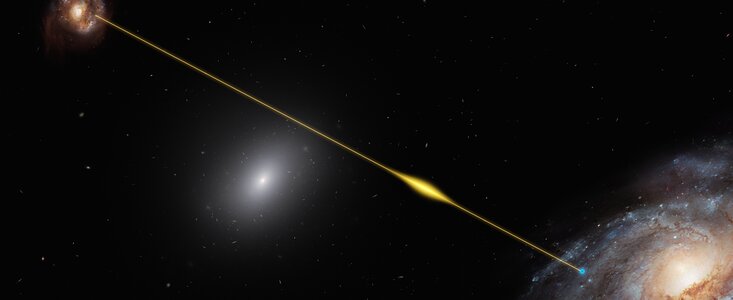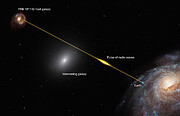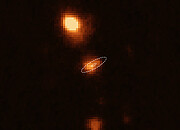Press Release
Enigmatic Radio Burst Illuminates a Galaxy’s Tranquil Halo
26 September 2019
Astronomers using ESO’s Very Large Telescope have for the first time observed that a fast radio burst passed through a galactic halo. Lasting less than a millisecond, this enigmatic blast of cosmic radio waves came through almost undisturbed, suggesting that the halo has surprisingly low density and weak magnetic field. This new technique could be used to explore the elusive halos of other galaxies.
Using one cosmic mystery to probe another, astronomers analysed the signal from a fast radio burst to shed light on the diffuse gas in the halo of a massive galaxy [1]. In November 2018 the Australian Square Kilometre Array Pathfinder (ASKAP) radio telescope pinpointed a fast radio burst, named FRB 181112. Follow-up observations with ESO’s Very Large Telescope (VLT) and other telescopes revealed that the radio pulses have passed through the halo of a massive galaxy on their way toward Earth. This finding allowed astronomers to analyse the radio signal for clues about the nature of the halo gas.
“The signal from the fast radio burst exposed the nature of the magnetic field around the galaxy and the structure of the halo gas. The study proves a new and transformative technique for exploring the nature of galaxy halos,” said J. Xavier Prochaska, professor of astronomy and astrophysics at the University of California Santa Cruz and lead author of a paper presenting the new findings published today in the journal Science.
Astronomers still don’t know what causes fast radio bursts and only recently have been able to trace some of these very short, very bright radio signals back to the galaxies in which they originated. “When we overlaid the radio and optical images, we could see straight away that the fast radio burst pierced the halo of this coincident foreground galaxy and, for the first time, we had a direct way of investigating the otherwise invisible matter surrounding this galaxy,” said coauthor Cherie Day, a PhD student at Swinburne University of Technology, Australia.
A galactic halo contains both dark and ordinary—or baryonic—matter that is primarily in the form of a hot ionised gas. While the luminous part of a massive galaxy might be around 30 000 light years across, its roughly spherical halo is ten times larger in diameter. Halo gas fuels star formation as it falls towards the centre of the galaxy, while other processes, such as supernova explosions, can eject material out of the star-forming regions and into the galactic halo. One reason astronomers want to study the halo gas is to better understand these ejection processes which can shut down star formation.
“This galaxy’s halo is surprisingly tranquil,” Prochaska said. “The radio signal was largely unperturbed by the galaxy, which is in stark contrast to what previous models predict would have happened to the burst.”
The signal of FRB 181112 was comprised of a few pulses, each lasting less than 40 microseconds (10 000 times shorter than the blink of an eye). The short duration of the pulses puts an upper limit on the density of the halo gas because passage through a denser medium would broaden the duration of the radio signal. The researchers calculated that the density of the halo gas must be less than 0.1 atoms per cubic centimeter (equivalent to several hundred atoms in a volume the size of a child’s balloon) [2].
“Like the shimmering air on a hot summer’s day, the tenuous atmosphere in this massive galaxy should warp the signal of the fast radio burst. Instead we received a pulse so pristine and sharp that there is no signature of this gas at all,” said coauthor Jean-Pierre Macquart, an astronomer at the International Center for Radio Astronomy Research at Curtin University, Australia.
The study found no evidence of cold turbulent clouds or small dense clumps of cool halo gas. The fast radio burst signal also yielded information about the magnetic field in the halo, which is very weak—a billion times weaker than that of a refrigerator magnet.
At this point, with results from only one galactic halo, the researchers cannot say whether the low density and low magnetic field strength they measured are unusual or if previous studies of galactic halos have overestimated these properties. Prochaska said he expects that ASKAP and other radio telescopes will use fast radio bursts to study many more galactic halos and resolve their properties.
“This galaxy may be special,” he said. “We will need to use fast radio bursts to study tens or hundreds of galaxies over a range of masses and ages to assess the full population.” Optical telescopes like ESO’s VLT play an important role by revealing how far away the galaxy that played host to each burst is, as well as whether the burst would have passed through the halo of any galaxy in the foreground.
Notes
[1] A vast halo of low-density gas extends far beyond the luminous part of a galaxy where the stars are concentrated. Although this hot, diffuse gas makes up more of a galaxy’s mass than stars do, it is very difficult to study.
[2] The density constraints also limit the possibility of turbulence or clouds of cool gas within the halo. Cool here is a relative term, referring to temperatures around 10 000°C, versus the hot halo gas at around 1 million degrees.
More information
This research was presented in a paper published on 26 September 2019 in the journal Science.
The team is composed of J. Xavier Prochaska (University of California Observatories-Lick Observatory, University of California, USA and Kavli Institute for the Physics and Mathematics of the Universe, Japan), Jean-Pierre Macquart (International Centre for Radio Astronomy Research, Curtin University, Australia), Matthew McQuinn (Astronomy Department, University of Washington, USA), Sunil Simha (University of California Observatories-Lick Observatory, University of California, USA), Ryan M. Shannon (Centre for Astrophysics and Supercomputing, Swinburne University of Technology, Australia), Cherie K. Day (Centre for Astrophysics and Supercomputing, Swinburne University of Technology, Australia and Commonwealth Science and Industrial Research Organisation, Australia Telescope National Facility, Australia), Lachlan Marnoch (Commonwealth Science and Industrial Research Organisation, Australia Telescope National Facility, Australia and Department of Physics and Astronomy, Macquarie University, Australia), Stuart Ryder (Department of Physics and Astronomy, Macquarie University, Australia), Adam Deller (Centre for Astrophysics and Supercomputing, Swinburne University of Technology, Australia), Keith W. Bannister (Commonwealth Science and Industrial Research Organisation, Australia Telescope National Facility, Australia), Shivani Bhandari (Commonwealth Science and Industrial Research Organisation, Australia Telescope National Facility, Australia), Rongmon Bordoloi (North Carolina State University, Department of Physics, USA), John Bunton (Commonwealth Science and Industrial Research Organisation, Australia Telescope National Facility, Australia), Hyerin Cho (School of Physics and Chemistry, Gwangju Institute of Science and Technology, Korea), Chris Flynn (Centre for Astrophysics and Supercomputing, Swinburne University of Technology, Australia), Elizabeth Mahony (Commonwealth Science and Industrial Research Organisation, Australia Telescope National Facility, Australia), Chris Phillips (Commonwealth Science and Industrial Research Organisation, Australia Telescope National Facility, Australia), Hao Qiu (Sydney Institute for Astronomy, School of Physics, University of Sydney, Australia), Nicolas Tejos (Instituto de Fisica, Pontificia Universidad Catolica de Valparaiso, Chile).
ESO is the foremost intergovernmental astronomy organisation in Europe and the world’s most productive ground-based astronomical observatory by far. It has 16 Member States: Austria, Belgium, Czechia, Denmark, France, Finland, Germany, Ireland, Italy, the Netherlands, Poland, Portugal, Spain, Sweden, Switzerland and the United Kingdom, along with the host state of Chile and with Australia as a Strategic Partner. ESO carries out an ambitious programme focused on the design, construction and operation of powerful ground-based observing facilities enabling astronomers to make important scientific discoveries. ESO also plays a leading role in promoting and organising cooperation in astronomical research. ESO operates three unique world-class observing sites in Chile: La Silla, Paranal and Chajnantor. At Paranal, ESO operates the Very Large Telescope and its world-leading Very Large Telescope Interferometer as well as two survey telescopes, VISTA working in the infrared and the visible-light VLT Survey Telescope. Also at Paranal ESO will host and operate the Cherenkov Telescope Array South, the world’s largest and most sensitive gamma-ray observatory. ESO is also a major partner in two facilities on Chajnantor, APEX and ALMA, the largest astronomical project in existence. And on Cerro Armazones, close to Paranal, ESO is building the 39-metre Extremely Large Telescope, the ELT, which will become “the world’s biggest eye on the sky”.
Links
Contacts
J. Xavier Prochaska
UCO/Lick Observatory — UC Santa Cruz
USA
Tel: +1 (831) 295-0111
Email: xavier@ucolick.org
Cherie Day
Centre for Astrophysics and Supercomputing — Swinburne University of Technology
Australia
Tel: +61 4 5946 3110
Email: cday@swin.edu.au
Mariya Lyubenova
ESO Head of Media Relations
Garching bei München, Germany
Tel: +49 89 3200 6188
Email: pio@eso.org
About the Release
| Release No.: | eso1915 |
| Name: | FRB 181112 |
| Type: | Early Universe : Galaxy : Activity : AGN |
| Facility: | Very Large Telescope |
| Instruments: | FORS2 |
| Science data: | 2019Sci...366..231P |





